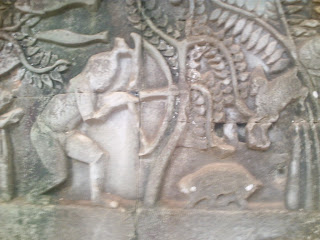15) Skin Diseases
Skin diseases in Cambodia are rampant because people get in touch with water a lot. Many people have herpes, and they seem to feel no shame about it. I heard that people who had herpes tend to take a bath immediately after having sexual intercourse, which caused the deaths of several people due to dysentery and cholera. In the marketplace, people sell medicines to cure various kinds of illnesses. But those medicines are different from Chinese medicines. There are also sorcerers who offer their craft for healing of ailments. How pathetic!
16) Funeral
The Cambodians do not use coffin for funeral. When a person died, people would use clothes and mats to wrap around the corpse and carry it into the forest to be left there for wild animals to consume. Sometimes, a funeral procession completed with music and flags was performed to honor the departed person. Along the way toward the resting place, relatives of the decease throw out popcorns or rice cereals as ritual offering to the supernatural beings. If wild animals consumed the corpse immediately after it has been left in the forest, it is believed that the spirit of the decease is at peace. However, if there were no animals coming to consume the corpse, it is believed that the spirit of the decease has not been free from sins.
Nowadays, some people cremated their deceased loved one. Those who have Chinese blood in their ethnic backgrounds, they no longer wear white clothes to mourn the death of their parents. They only shave their heads, for males, and cut off some hair on the foreheads, for females, to indicate mourning for deceased parents. As for Kings, there are mausoleums for their burials, but I do not know if their bodies were buried in whole or just the ashes.
17) Agricultural Activities
The Cambodians could probably cultivate 3 to 4 crops annually, for all four seasons in Cambodia are suitable for agricultural activities. Weatherwide, Cambodia has never had snow or frozen rain. In each year, rain falls for about 6 months, and the other 6 months would go without any rain. From the 4th to the 9th month, the rain would fall in every afternoon. During this period, the fresh water sea (Tonle Sap Lake) begins to swell and rise up to the height of about 70 to 80 hathas (100-115ft.). Most trees growing around the lake’s shores are all submerged. Only the tops of their branches remain visible. As for the people who live near or on the lake’s shores, they all move their shelters to settle on higher ground.
From the 10th to the 3rd month of the following year, there are no rainfalls. During this period, the fresh water sea (Tonle Sap Lake) recedes and become shallow. At the deepest point, the bottom of the lake is only 3 or 5 hatha deep which is navigable for only small ship. At that point, the people begin to resettle the lakeshores where they could grow rice and other crops near the shorelines. By the time the rice is harvested, it is also time for the water in the lake to begin to rise up again. Farmers who cultivate crops along the lakeshores clear and maintain their individual plots. They do not use oxen to plow their field. (In this case, they might be using water buffaloes, Chou Ta-Kuan did not elaborate on it). Their hoes and sickles, although look similar, are not like those used in China. There is one kind of wild rice which grows really fast in the water. If the water rose up to 10 hatha height, this rice would grow as much in length. People grow this kind of rice during the flooding season.
The Cambodians do not use human wastes in their vegetable or rice seedling beds, for they consider it repugnant. The Chinese who have come to Cambodia never told the Cambodians of the human waste containers used in China to collect manure to turn it into fertilizer, for they fear that the Cambodians might shun them. The Cambodians dig a pitch in the ground and build a small thatched hut over it to be used as toilet. Once the pitch is filled up, they would cover it up and dig a new one. After going to the toilet, folks here always go into a pond to wash themselves. They use their left hand to do the washing job while reserving the right hand for eating. When the Cambodians see the Chinese go to the toilet and using paper towels to perform the hygienic functions, they are startled about it and feel uneasy about allowing those Chinese entering their homes. The women folks in this country pee standing up just like men. How funny!
(Excerpt from the Cambodian Royal Chronicle, To be continued)
Subscribe to:
Post Comments (Atom)
ចំណីខួរក្បាល
កិច្ចព្រមព្រៀង កិច្ចព្រមព្រៀង គឺជាពាក្យមួយ ដែលមានអត្ថន័យ ទូលំទូលាយ ។ ហើយវាក៏ជាពាក្យមួយ ដែលបង្កឲ្យមានគ្រោះមហន្តារាយ មកលើមនុស្សជាតិ ជាច្រើនដ...
-
រឿង តោនិងក្របីព្រៃ តោមួយបានដើរស្វែងរកអាហារ នៅក្បែរមាត់ព្រៃ ។ នៅពេលវាដើរ មកដល់ក្បែរមាត់បឹងមួយ វាបានឃើញក្របីព្រៃឈ្មោលចំនួនបួន កំពុង ឈរស៊ីស...
-
រឿង ក្មេងប្រុសនិងសត្វកង្កែប មានក្មេងប្រុសមួយក្រុម បាននាំគ្នាទៅរត់លេង នៅក្បែរមាត់ត្រពាំងមួយ ដែលមានសត្វកង្កែបជាច្រើនរស់នៅ ។ បន្ទាប់ពីពួកគេរត...
-
រឿង សត្វលានិងរូបចម្លាក់ បុរសម្នាក់បានផ្ទុករូបចម្លាក់ព្រះពុទ្ធបដិមាករ ដែលធ្វើអំពីឈើមួយអង្គ នៅលើខ្នងលា ដើម្បីដឹកយកទៅដាក់នៅក្នុងព្រះវិហារ ។ ...




No comments:
Post a Comment